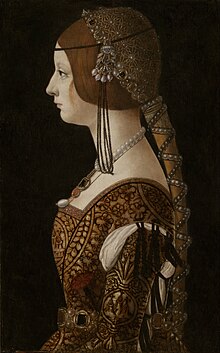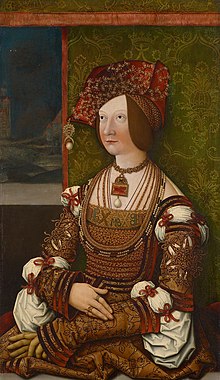Bianca Maria Sforza

Bianca Maria Sforza also Maria Blanca Sforza (born April 5, 1472 in Milan , † December 31, 1510 in Innsbruck ) was the second wife of the Roman-German King Maximilian I (1459-1519). From 1494 she was Roman-German Queen and Archduchess of Austria and from 1508 Empress of the Holy Roman Empire.
Childhood and youth
Bianca Maria was a daughter of Duke Galeazzo Maria Sforza of Milan and his second wife Bona of Savoy (born August 10, 1449 , † November 17, 1503 ). After her father was murdered in 1476, she grew up at the court of her uncle Ludovico Sforza , who had taken over government in 1481. Bianca Maria's life at the court of her wealthy uncle was varied, as he had tied many important artists of the time to his court, including Leonardo da Vinci , who had been in the service of Milan from around 1482. No great emphasis was placed on Bianca Maria's education, and so she was able to devote herself to her interests, such as making the finest handicrafts, where she showed great skill. In 1476, at the age of 4, she was married to the 11-year-old Philibert I of Savoy , who died at the age of 17.
Next life

A wedding organized by her uncle Ludovico Sforza with the Roman-German King Maximilian I was supposed to give the ruler of Milan known as "Il Moro" the title of duke , since the Duchy of Milan was a fiefdom of the Holy Roman Empire . Ludovico had usurped the throne of Milan and in 1481 disempowered the rightful heir to the ducal throne Gian Galeazzo Sforza and his mother, the regent Bona of Savoy . Gian Galeazzo died in 1494. Contemporary witnesses, such as the French diplomat Philippe de Commynes in his memoirs , spoke of murder.
To make the improper marriage palatable to the German king, Ludovico offered a dowry of 400,000 ducats in cash and a further 40,000 ducats in jewels. This argument convinced Maximilian, who was in constant financial difficulties. In return, Ludovico received the title of duke.
On November 30, 1493, Bianca Maria Sforza was married to King Maximilian I in Milan in a proxy wedding (per procurationem) in the absence of the groom .
In late autumn Bianca Maria traveled with her dowry and a large escort over the snow-covered Wormser Joch to Innsbruck , where she waited three months for Maximilian, as he was prevented by a Turkish invasion of Styria and the reorganization of the Lower Austrian states. The marriage was therefore not consummated until March 16, 1494 in Hall and the marriage was celebrated with a joint "church attendance under the crown" in Hall and Innsbruck.
Shortly after the consummation of the marriage , Maximilian complained that Bianca could compete with his first wife Maria of Burgundy in terms of beauty , but that she had only a mediocre mind.
It was impossible for the young woman to win her husband's affection, since in his eyes she was too ignorant, too talkative, too naive, too lavish and too sloppy. According to Hermann Wiesflecker , Bianca Maria remained “all her life a child who played sitting on the floor” and was not aware of her position as Maximilian's wife. There was also the fact that Maximilian wanted her to have children, but they did not happen despite several pregnancies.
This was one of the reasons why Maximilian became increasingly estranged from her, neglected her and returned to his lover, who gave him nine children. It even got to the point that he left Bianca Maria and her court several times behind as pledge when he could not pay his debt to the landlords. (According to Sabine Weiss, this view is incorrect. Maximilian did not leave his wife behind several times as a pledge for his debts, but, if she could not leave again, it was always her own debts or outstanding bills from her court that were still being paid had to be).
After 1500 Maximilian finally lost interest in Bianca Maria, not least because her uncle Ludovico was in a war against Ludwig XII in 1499 . of France had lost the Duchy of Milan . Ludovico initially fled to Innsbruck, but returned to Milan, where he was taken prisoner by the French, which meant that he failed to become Maximilian's financier.
Bianca Maria was also absent from Maximilian's proclamation as "Elected Emperor" on February 4, 1508 in Trento.
When Bianca Maria died in Innsbruck on December 31, 1510, Maximilian was staying in Freiburg . He did not attend her funeral, but only returned to Innsbruck in June 1511. Bianca Maria was buried in the princely crypt of the Cistercian monastery in Stams in the Inn valley west of Innsbruck . Maximilian didn't even dedicate a tombstone to her. Only in the 1680s was a gilded statue dedicated to her in the so-called “Austrian grave” .
Aftermath

Joseph Grünpeck, the Regensburg-born historian at Maximilian's court, was of the opinion that after three years of constant emaciation she had died of "dörrsucht" ( cachexia ), and blamed Maximilian for neglecting his wife.
A relief on the Golden Roof in Innsbruck commemorates her marriage to King Maximilian .
A bronze statue from the 16th century in the court church in Innsbruck commemorates Bianca Maria.
The Empress and Maximilian I are depicted under the cloak of the Frauenstein Madonna . The Madonna is a work by Gregor Erhart .
literature
Lexica entries
- Constantin von Wurzbach : Habsburg, Blanca Maria of Milan . In: Biographisches Lexikon des Kaiserthums Oesterreich . 6th part. Imperial-Royal Court and State Printing Office, Vienna 1860, p. 156 ( digitized version ).
- Ernst Bock: Bianca Maria Sforza. In: New German Biography (NDB). Volume 2, Duncker & Humblot, Berlin 1955, ISBN 3-428-00183-4 , p. 214 ( digitized version ).
Biographical presentations
- Hermann Wiesflecker : Maximilian I . Vienna / Munich 1991, ISBN 3-7028-0308-4 and ISBN 3-486-55875-7
- Sabine Weiss: The forgotten empress. Bianca Maria Sforza. Tyrolia, Innsbruck 2010 ISBN 978-3-7022-3088-3 (review by Julia Hörmann-Thurn and Taxis, in: Elena Taddei - Michael Müller - Robert Rebitsch (ed.): Migration and Travel. Mobility in the Early Modern Age (= Innsbruck Historical Studies 28), Innsbruck / Vienna / Bozen: Studien Verlag, 2012, p. 377f.)
Scientific work on partial aspects
- Christina Antenhofer: Emotions in the Correspondence of Bianca Maria Sforza. In: Heinz Noflatscher / Michael A. Chisholm / Bertrand Schnerb (eds.): Maximilian I. 1459-1519. Perception - Translations - Gender. Innsbruck Historical Studies (27) Innsbruck 2011. pp. 267–286. ISBN 978-3-7065-4951-6
- Christina Lutter: Gender, Relationship, Politics. What possibilities and limits of "successful" action did Bianca Maria Sforza have? . In: Heinz Noflatscher / Michael A. Chisholm / Bertrand Schnerb (eds.): Maximilian I. 1459-1519. Perception - Translations - Gender . Innsbruck Historical Studies (27) Innsbruck 2011. pp. 251–266. ISBN 978-3-7065-4951-6
- Daniela Unterholzner: Everyday food at court. To Bianca Maria Sforza's wife . In: Heinz Noflatscher / Michael A. Chisholm / Bertrand Schnerb (eds.): Maximilian I. 1459-1519. Perception - Translations - Gender . Innsbruck Historical Studies (27) Innsbruck 2011. pp. 286–301. ISBN 978-3-7065-4951-6
Popular science presentations
- Hellmut Andics : The women of the Habsburgs. J&V, Vienna 1985
- Sigrid-Maria Großering : Maximilian I. Kaiser - Artist - Fighter . Amalthea, Vienna 2002 ISBN 3-85002-485-7
- Thea Leitner : Habsburg's Golden Brides . Piper, Munich 2005
Web links
Individual evidence
- ↑ Sigrid-Maria Großering : She brought him the money, and he didn't make her happy , Kronenzeitung , article December 2, 2007.
- ↑ Hermann Wiesflecker: Maximilian I , 1991, p. 80.
- ↑ Hermann Wiesflecker: Maximilian I , 1991, pp. 80–81 and p. 392.
- ↑ a b Hermann Wiesflecker: Maximilian I , 1991, p. 81.
- ↑ Hermann Wiesflecker: Maximilian I , 1991, p. 81; P. 157: p. 218.
- ↑ Sabine Weiss: The forgotten empress. Bianca Maria Sforza. Tyrolia, Innsbruck 2010.
- ↑ Hermann Wiesflecker: Maximilian I , 1991, p. 158.
- ↑ Viktor von Kraus , Itinerarium Maximiliani I 1508–1518 , in: Archives for Austrian Coating Volume 87, Vienna 1899, p. 285.
- ↑ Angela Mohr: The protective coat Madonna von Frauenstein. Steyr: Verlag Ennsthaler 1986 2nd edition p. 25ff. ISBN 3-85068-132-7 .
| predecessor | Office | Successor |
|---|---|---|
| Eleonore Helena of Portugal |
Holy Roman Empress February 4, 1508 to December 31, 1510 |
Isabella of Portugal (1503–1539) |
| personal data | |
|---|---|
| SURNAME | Sforza, Bianca Maria |
| BRIEF DESCRIPTION | Wife of Maximilian I (HRR) |
| DATE OF BIRTH | April 5, 1472 |
| PLACE OF BIRTH | Milan |
| DATE OF DEATH | December 31, 1510 |
| Place of death | innsbruck |